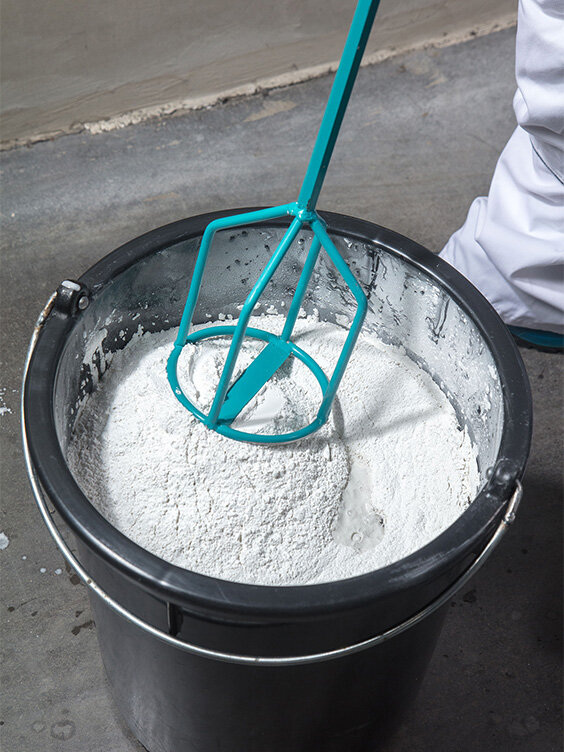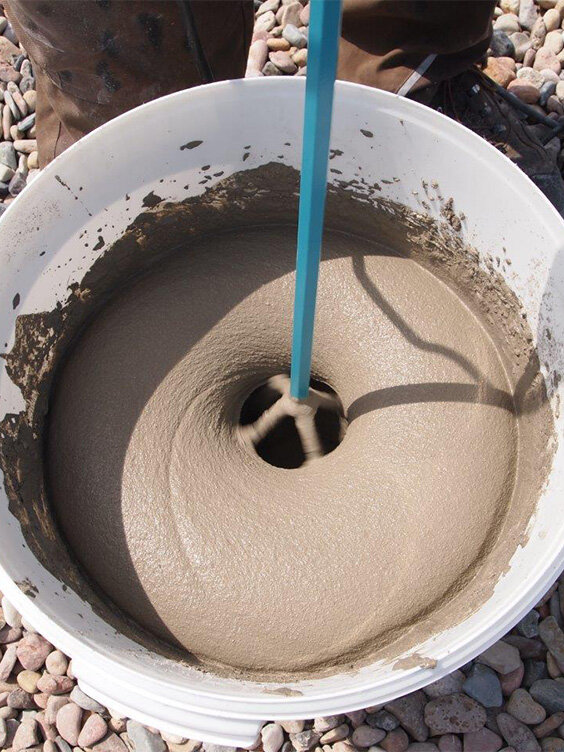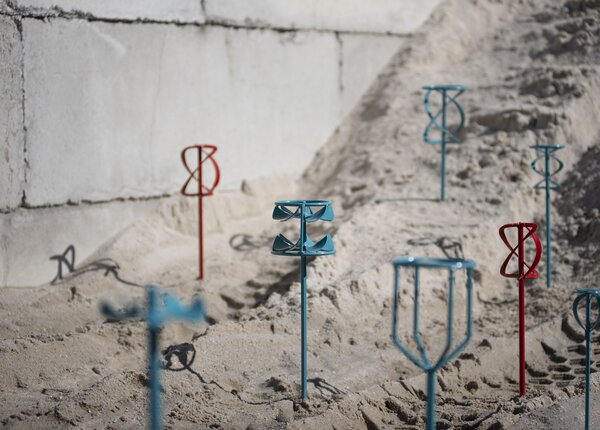
The Benefits of Mixing Properly
How to Mix Tile Adhesive for Exceptional Results
When you lay tiles for a living, you know that the right materials, supplies, and tools can make a big difference in your bottom line, especially when you know how important it is to mix tile adhesives correctly.
In this article, we'll look at the different types of tile adhesive, the proper method for mixing, the tools you need to get a consistent mix, and finally, the mixing process. This will give you all the information you need to mix the tile adhesive properly, so that you get great results that will last for many years to come.

What is Tile Adhesive?
Simply put, tile adhesive is a special adhesive for laying ceramic tiles on the floor or wall. For the most reliable result, use a ready-made formula. These so-called “dry mixes” are chemically constructed and formulated just for tile. Unlike homemade cement mortars, these tile adhesives are precisely matched to the substrate that you are trying to cover, the ceramic being used, and the tile size. These cement-based adhesives usually consist of mixtures made of fine sand and a range of chemical additives, resulting in a significantly different composition than conventional mortars. These are considered hydraulically setting tile adhesives. In comparison, there are also dispersion adhesives - aka- epoxy resins.
Depending on the varying factors that influence the tile job like substrate, height of the material, intended physical load, tile size, exposure to moisture, or even frost, take into account the installation method.
Can You Mix Tile Adhesive By Hand?
It is not recommended and we would advise, “not possible” to mix by hand. Mixing by hand makes it difficult to avoid getting lumps and air bubbles. Having the right tools for the job can make the difference between a great job that will last a long time and one that will have issues such as delaminating tiles or similar issues. You should use a mixing paddle that provides plenty of torque and shear, but without as much vertical mixing to avoid air entrainment.
The method used for laying tiles plays a decisive role. Ready-mixed tile adhesive is applied with a notched trowel. There are different sizes of teeth to apply the material accordingly. If the substrate to be covered is absolutely level and dimensionally stable, the adhesive is applied using the so-called “thin-bed” method. The advantage here is that less adhesive is required and the laying of the tiles proceeds quite quickly. The floating/buttering or thick-method is also frequently used for tiling. This means that both the substrate and the back of the tile are coated with adhesive. In this way, the tile can be pressed firmly into the adhesive bed, a full-surface bond is achieved and the tile itself can also be adjusted accordingly.
For large-format tiles, natural stone tiles, outdoor applications, or uneven substrates; the thick-bed method is used. These thick-bed mortars have high stability and allow the level alignment of uncalibrated tiles.
The Right Tools for Consistent Mixing
Select the Right Mixer for Tile Adhesive
To start, you'll want to make sure you have the right mixer for your project. Let's start by talking about using drills for this process. Drills are great for high-speed, low-torque applications - everything that mixing mortar should not be. Fast speeds cause splatter and air entrainment, and low torque makes it hard on the drill motor to manage the job without overheating or burning out.
Having a dedicated mixer motor means you've got a lower-speed, high-torque motor designed for the job. If you're only running a small crew and projects that only require a small amount of tile adhesive mixed at a time, the Xo1R has a strong, but not overpowering, 1.4HP motor for these purposes. By comparison, the Xo6R features two speeds and a powerful 2.1HP motor that will keep up with most needs. For large jobs that require constant mixing while still maintaining quality control, the AOX-S with the KR paddle Colomoatic delivers.

Choose the Mixing Paddle
Your next decision is which mixing paddle to use to get the soft-creamy, smooth, and lump-free consistency you need in tile adhesive. This result is achieved when a stirrer is used. This has a two-fold result: on one hand, it actively works against lumps forming from the start. On the other hand, it quickly mixes the ingredients into the water. Ideally, the chosen paddle has a high shear force that cuts through the material and doesn’t overload the stirring basket with material.
The suitable paddle for this is the KR type, or “bird cage” paddle. The KR homogenizes the material in a significantly shorter time than any comparable tool due to its parallel mixing action. At the same time, the thorough mixing also ensures that the tile adhesive remains open longer, thus extending the processing time.
Find the Right Mixing Container and Accessories
Mixing containers can include anything from large buckets to tubs, but should always be durable and portable so that you can move the mix as you work, depending on the size of the project. However, that isn't the end of what you need. Dust extractors are becoming more important in the mixing process with the new OSHA airborne silica requirements as well.
You'll also want to carefully control how much water is being added to dry or concentrated tile adhesive mixes. Though you could do this with an arrangement of buckets of known size, measuring cups, and similar approaches, a precision water dispensing instrument like the Aqix is a better way to go. Simply enter the amount of water needed, attach the tool to the side of the bucket, and dispense the right amount at the push of a button, keeping your batches very consistent.
How to Mix Tile Adhesive
1. Read the instructions for all materials. This is important, because your surface sealant may need to set for a particular amount of time prior to applying your adhesive.
2. Prep your surfaces. Whether it's adding a bonding agent, washing down dusty tileboard, or similar approaches, make sure that your material, your equipment, and crew is ready to go before you start mixing to avoid going past the usable pot life of the tile adhesive. Use proper personal protective equipment.
3. Add water first. To avoid having dry adhesive clumps at the bottom, add water to your container first, even if it's only a small amount to get started with before you add more later in the mixing process.
4. Add the tile adhesive. This is the most important time to have a dust extractor operating, so that you can keep your worksite healthy and your crew functioning well. Add the adhesive slowly to ensure a smooth mix and avoid splashing.
5. Stir. Though this seems like a simple process, take some time with it. Make sure you have the right tools for the job, and if possible, start at the bottom at a slower speed, then speed up a bit as the mix begins to flow. Be sure to hit the sides and bottom to incorporate all material.
6. Continue mixing until smooth. You want to ensure that you have no lumps in your tile adhesive, so be sure to keep your paddle low in the container and allow the flow to move the lumps through the mixer.
7. Apply in small amounts. As tile adhesive is spread on a wall or other surface, it tends to start setting up much more quickly, so make sure that you're working in small amounts on the surface while keeping the rest in the bucket to reduce its surface area.
8. If working with a crew, keep it moving. Have someone time the first batch from start to finish of the application to time mixing and keep things moving efficiently, then adapt that time as needed for picking up a rhythm or slowing down for the day.
By keeping these aspects in mind of how to mix adhesive for tiles, you'll be able to handle the process quickly and efficiently in no time. Make sure to use the right tools, wear your personal protective equipment when mixing to protect worker health, mix consistently and thoroughly with the right accessories, time your batches to your workflow, and keep things moving so that you'll get great results without wasting a lot of time in the process. By doing so, you'll get consistent results every time, delivering a project to the client that will last for many years and perform well under pressure while improving your bottom line and overall profitability.
